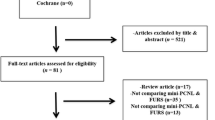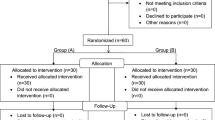Abstract
Renal stone disease is becoming increasingly prevalent globally. With a rise in stone disease worldwide, there is also a relative increase in the rates of surgical intervention. Technological advances have allowed a move towards minimising the complications rates and length of stay with a reduction in invasiveness and size of instruments. A trend for minimising the percutaneous tract size has been noted in percutaneous nephrolithotomy (PCNL) for renal stones. The management has shifted from open surgery to standard PCNL, mini-PCNL and the latest ultra-mini and micro-PCNL techniques. There is a need to compare outcomes for the ever-advancing technologies, such as the smaller calibre of instruments, to assess risk-benefit in practice. This review looks at outcome-based comparison of percutaneous procedures for urinary lithiasis with instruments <12Fr in size.
Similar content being viewed by others
References
Papers of particular interest, published recently, have been highlighted as: • Of importance,•• Of major importance
Fernström I, Johansson B. Percutaneous pyelolithotomy: a new extraction technique. Scand J Urol Nephrol. 1976;10(3):257–9.
Jackman SV et al. Percutaneous nephrolithotomy in infants and preschool age children: experience with a new technique. Urology. 1998;52:697–701.
Mishra et al. Prospective comparative study of miniperc and standard PNL for treatment of 1 to 2cm size renal stone. BJUI. 2011;108(6):898–9.
Tepeler et al. The role of microperc in the treatment of symptomatic lower pole renal calculi. J Endourol. 2013;27(1):13–8. This is a retrospective study for patients undergoing mPCNL who previously failed RIRS or ESWL. They report good outcomes in patients with lower pole stones, proposed as an ideal use for mPCNL.
Piskin et al. Preliminary, favourable experience with mircoperc in kidney and bladder stones. J Endourol. 2012;26(11):1443–7.
Sabnis et al. Micropercutaneous nephrolithotomy (microperc) vs retrograde intrarenal surgery for the management of small renal calculi: a randomized controlled trial. BJUI. 2013;112:355–61. This is a recent, good quality randomised control trial. They have shown that mPCNL can provide comparable stone clearance against RIRS with comparable hospital stay.
Armagan et al. Micropercutaneous nephrolithotomy in the treatment of moderate-size renal calculi. J Endourol. 2013;27(2):177–81. This paper has shown that stones of significant size, that previously would have been recommended for standard PCNL, can be successfully treated by mPCNL with impressive stone free rates.
Romero V, Akpinar H, Assimos D. Kidney stones: a global picture of prevalence, incidence and associated risk factors. Rev Urol. 2010;12(2/3):e86–96.
Turk et al. Guidelines on urolithiasis. European Association of Urology. 2014
Opondo et al. Standardization of patient outcomes reporting in percutaneous nephrolithotomy. J Endourol. 2014;28(7):767–74.
Karakose A, Aydogdu O, Atesci YZ. Does the use of smaller Amplatz sheath size reduce complication rates in percutaneous nephrolithotomy? Urol J. 2014;11(4):1752–6.
Ali S, Kumar N, Baloch U. Outcome of percutaneous nephrolithotomy. J Coll Phys Surg Pak. 2014;24(4):261–4.
Sivalingam S, Cannon ST, Nakada SY. Current practices in percutanous nephrolithotomy among endourologists. J Endourol. 2014;28(5):524–7.
Srisubat et al. Extracorporeal shockwave lithotripsy (ESWL) versus percutaneous nephrolithotomy (PCNL) or retrograde intrarenal surgery (RIRS) for kidney stones. Cohcrane Database Syst Rev. 2009; 7(4)
Zheng et al. Retrograde intrarenal surgery versus percutaneous nephrolithotomy for treatment of renal stones >2cm: A Meta-Analysis. Urol Int. 2014.
Compliance with Ethics Guidelines
Conflict of Interest
The authors declare that they have no competing interests.
Human and Animal Rights and Informed Consent
This article does not contain any studies with human or animal subjects performed by any of the authors.
Author information
Authors and Affiliations
Corresponding author
Additional information
This article is part of the Topical Collection on Minimally Invasive Surgery
Rights and permissions
About this article
Cite this article
Wells, H., Rukin, N., Wright, A. et al. Outcome-Based Comparison of Percutaneous Procedures for Urinary Lithiasis with Calibre of Instrumentation less than 12Fr. Curr Urol Rep 16, 53 (2015). https://doi.org/10.1007/s11934-015-0528-4
Published:
DOI: https://doi.org/10.1007/s11934-015-0528-4




